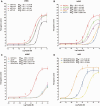Functional Pairing of Class B1 Ligand-GPCR in Cephalochordate Provides Evidence of the Origin of PTH and PACAP/Glucagon Receptor Family
- PMID: 25841489
- PMCID: PMC4833073
- DOI: 10.1093/molbev/msv087
Functional Pairing of Class B1 Ligand-GPCR in Cephalochordate Provides Evidence of the Origin of PTH and PACAP/Glucagon Receptor Family
Abstract
Several hypotheses have been proposed regarding the origin and evolution of the secretin family of peptides and receptors. However, identification of homologous ligand-receptor pairs in invertebrates and vertebrates is difficult because of the low levels of sequence identity between orthologs of distant species. In this study, five receptors structurally related to the vertebrate class B1 G protein-coupled receptor (GPCR) family were characterized from amphioxus (Branchiostoma floridae). Phylogenetic analysis showed that they clustered with vertebrate parathyroid hormone receptors (PTHR) and pituitary adenylate cyclase-activating polypeptide (PACAP)/glucagon receptors. These PTHR-like receptors shared synteny with several PTH and PACAP/glucagon receptors identified in spotted gar, Xenopus, and human, indicating that amphioxus preserves the ancestral chordate genomic organization of these receptor subfamilies. According to recent data by Mirabeau and Joly, amphioxus also expresses putative peptide ligands including homologs of PTH (bfPTH1 and 2) and PACAP/GLUC-like peptides (bfPACAP/GLUCs) that may interact with these receptors. Functional analyses showed that bfPTH1 and bfPTH2 activated one of the amphioxus receptors (bf98C) whereas bfPACAP/GLUCs strongly interacted with bf95. In summary, our data confirm the presence of PTH and PACAP/GLUC ligand-receptor pairs in amphioxus, demonstrating that functional homologs of vertebrate PTH and PACAP/glucagon GPCR subfamilies arose before the cephalochordate divergence from the ancestor of tunicates and vertebrates.
Keywords: GPCR; PACAP/glucagon; PTH; amphioxus.
© The Author 2015. Published by Oxford University Press on behalf of the Society for Molecular Biology and Evolution. All rights reserved. For permissions, please e-mail: journals.permissions@oup.com.
Figures






Similar articles
-
Tracing the Origins of the Pituitary Adenylate-Cyclase Activating Polypeptide (PACAP).Front Neurosci. 2020 May 20;14:366. doi: 10.3389/fnins.2020.00366. eCollection 2020. Front Neurosci. 2020. PMID: 32508559 Free PMC article.
-
Hypophysiotropic action of pituitary adenylate cyclase-activating polypeptide (PACAP) in the goldfish: immunohistochemical demonstration of PACAP in the pituitary, PACAP stimulation of growth hormone release from pituitary cells, and molecular cloning of pituitary type I PACAP receptor.Endocrinology. 1998 Aug;139(8):3465-79. doi: 10.1210/endo.139.8.6145. Endocrinology. 1998. PMID: 9681497
-
The origin and function of the pituitary adenylate cyclase-activating polypeptide (PACAP)/glucagon superfamily.Endocr Rev. 2000 Dec;21(6):619-70. doi: 10.1210/edrv.21.6.0414. Endocr Rev. 2000. PMID: 11133067 Review.
-
The secretin G-protein-coupled receptor family: teleost receptors.J Mol Endocrinol. 2005 Jun;34(3):753-65. doi: 10.1677/jme.1.01730. J Mol Endocrinol. 2005. PMID: 15956345
-
PACAP, VIP and their receptors in the metazoa: insights about the origin and evolution of the ligand-receptor pair.Peptides. 2007 Sep;28(9):1902-19. doi: 10.1016/j.peptides.2007.05.016. Epub 2007 Jul 31. Peptides. 2007. PMID: 17826180 Review.
Cited by
-
PACAP/GCGa Is an Important Modulator of the Amphioxus CNS-Hatschek's Pit Axis, the Homolog of the Vertebrate Hypothalamic-Pituitary Axis in the Basal Chordates.Front Endocrinol (Lausanne). 2022 Apr 14;13:850040. doi: 10.3389/fendo.2022.850040. eCollection 2022. Front Endocrinol (Lausanne). 2022. PMID: 35498398 Free PMC article.
-
Glycyrrhizic Acid Reduces Heart Rate and Blood Pressure by a Dual Mechanism.Molecules. 2016 Sep 27;21(10):1291. doi: 10.3390/molecules21101291. Molecules. 2016. PMID: 27689971 Free PMC article.
-
Tracing the Origins of the Pituitary Adenylate-Cyclase Activating Polypeptide (PACAP).Front Neurosci. 2020 May 20;14:366. doi: 10.3389/fnins.2020.00366. eCollection 2020. Front Neurosci. 2020. PMID: 32508559 Free PMC article.
-
Pth4, an ancient parathyroid hormone lost in eutherian mammals, reveals a new brain-to-bone signaling pathway.FASEB J. 2017 Feb;31(2):569-583. doi: 10.1096/fj.201600815R. Epub 2016 Oct 24. FASEB J. 2017. PMID: 28148780 Free PMC article.
-
New Insights into the Structure and Function of Class B1 GPCRs.Endocr Rev. 2023 May 8;44(3):492-517. doi: 10.1210/endrev/bnac033. Endocr Rev. 2023. PMID: 36546772 Free PMC article.
References
-
- Abascal F, Zardoya R, Posada D. ProtTest: selection of best-fit models of protein evolution. Bioinformatics. 2005;21:2104–2105. - PubMed
-
- Bayliss A, Evans PD. Characterisation of AmphiAmR4, an amphioxus (Branchiostoma floridae) alpha(2)-adrenergic-like G-protein-coupled receptor. Invert Neurosci. 2013a;13:71–84. - PubMed
-
- Bourgault S, Vaudry D, Segalas-Milazzo I, Guilhaudis L, Couvineau A, Laburthe M, Vaudry H, Fournier A. Molecular and conformational determinants of pituitary adenylate cyclase-activating polypeptide (PACAP) for activation of the PAC1 receptor. J Med Chem. 2009;52:3308–3316. - PubMed
Publication types
MeSH terms
Substances
LinkOut - more resources
Full Text Sources
Other Literature Sources
Molecular Biology Databases
Research Materials

